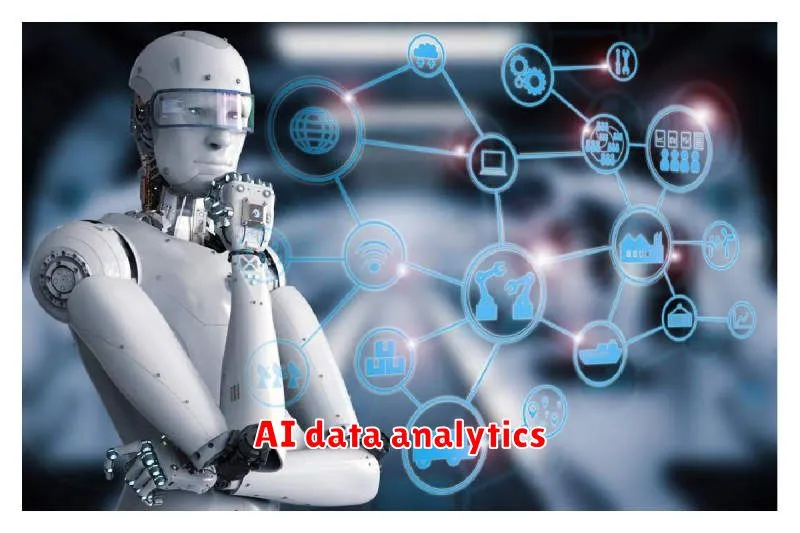In today’s data-driven world, businesses are drowning in information. But what good is data without the tools to turn it into actionable insights? That’s where AI-driven analytics tools come in. These cutting-edge platforms leverage the power of artificial intelligence to unlock hidden patterns, predict future trends, and empower data-driven decision-making. From automating tedious tasks to uncovering hidden opportunities, AI-powered analytics tools are transforming the way businesses operate, and this article delves into the exciting possibilities.
Whether you’re a seasoned data scientist or a business leader seeking to harness the power of data, this deep dive into AI-driven analytics will equip you with the knowledge and insights you need to navigate the ever-evolving data landscape. We’ll explore the latest trends in AI-powered analytics, examine the key features and benefits of these tools, and provide practical examples of how businesses across industries are using them to gain a competitive edge. Join us as we unravel the potential of AI-driven analytics and discover how it can empower you to make smarter, data-driven decisions.
The Rise of AI in Data Analytics

The realm of data analytics is undergoing a transformative revolution, driven by the rapid advancements in artificial intelligence (AI). This technological leap is empowering businesses to unlock unprecedented insights from their data, leading to smarter decision-making and improved outcomes. AI-driven analytics tools are becoming increasingly sophisticated, enabling organizations to analyze vast amounts of data with greater accuracy, speed, and efficiency than ever before.
One of the key areas where AI is making a significant impact is in automated data preparation. Traditional data preparation processes can be time-consuming and error-prone, but AI algorithms can now automate these tasks, freeing up data scientists and analysts to focus on higher-value activities. Machine learning (ML) techniques are also revolutionizing the way data is analyzed, enabling the identification of complex patterns and relationships that would be impossible to detect using traditional methods.
The rise of AI in data analytics is also giving birth to new and innovative tools, such as natural language processing (NLP), which allows businesses to analyze and understand unstructured data, such as text and audio. This capability is crucial for organizations seeking to gain insights from customer feedback, social media posts, and other valuable sources of information. Moreover, AI-powered predictive analytics tools are enabling businesses to forecast future trends and outcomes, improving their ability to make proactive decisions and adapt to changing market conditions.
The benefits of AI-driven analytics are undeniable. By automating tasks, uncovering hidden insights, and enabling predictive capabilities, AI is empowering businesses to make more informed decisions, optimize operations, and drive innovation. As AI technologies continue to evolve, we can expect even greater advancements in data analytics, further transforming the way businesses operate and compete in the digital age.
Understanding AI-Driven Data Analytics Tools
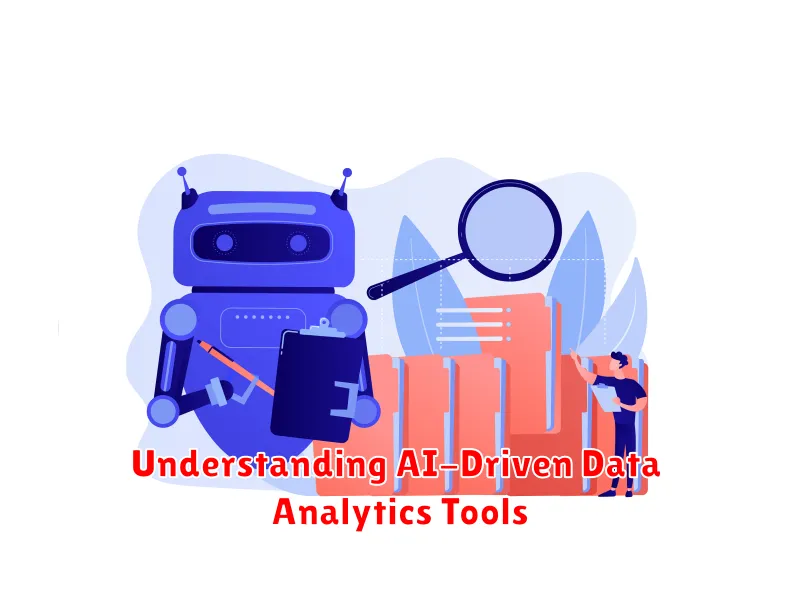
In today’s data-driven world, businesses are constantly seeking ways to extract insights and make informed decisions. AI-driven data analytics tools are revolutionizing how we analyze data, offering unparalleled capabilities to uncover hidden patterns, predict future trends, and optimize business operations.
These tools leverage advanced algorithms like machine learning and deep learning to automate data analysis tasks. They can handle massive datasets, identify complex relationships, and generate actionable insights that would be impossible to achieve with traditional methods.
Here’s a breakdown of key features and functionalities of AI-driven data analytics tools:
Key Features of AI-Driven Data Analytics Tools:
- Automated Data Preparation: AI tools can clean, transform, and prepare data for analysis, saving time and reducing human error.
- Predictive Analytics: By analyzing historical data, these tools can forecast future outcomes, enabling businesses to make proactive decisions.
- Pattern Recognition: AI algorithms can detect hidden patterns and anomalies in data, revealing insights that might otherwise go unnoticed.
- Natural Language Processing (NLP): Some tools allow users to interact with data using natural language queries, making analysis more accessible.
- Data Visualization: AI-powered dashboards and visualizations present insights in an intuitive and easily understandable manner.
Benefits of AI-Driven Data Analytics Tools:
- Improved Decision-Making: Data-driven insights lead to more informed and strategic decisions.
- Enhanced Efficiency: Automation reduces manual tasks, freeing up time for more strategic initiatives.
- Competitive Advantage: Businesses that leverage AI for data analysis gain a competitive edge by extracting valuable insights from their data.
- Personalized Customer Experiences: AI-powered insights can be used to personalize customer interactions and provide tailored services.
- Reduced Risk: Predictive analytics can help identify potential risks and prevent costly mistakes.
In conclusion, AI-driven data analytics tools are empowering businesses to unlock the full potential of their data. By automating complex analysis tasks, providing actionable insights, and enabling data-driven decision-making, these tools are transforming industries and driving innovation.
Benefits of Using AI for Data Analysis

In today’s data-driven world, organizations are overwhelmed with vast amounts of information. Extracting meaningful insights from this data deluge can be a daunting task. This is where artificial intelligence (AI) comes into play, revolutionizing data analysis and unlocking hidden potential. AI-driven analytics tools offer a multitude of benefits, empowering businesses to make informed decisions and gain a competitive edge.
One of the most significant advantages of using AI for data analysis is its ability to automate repetitive tasks. AI algorithms can sift through massive datasets, identify patterns, and generate reports with minimal human intervention. This frees up analysts to focus on higher-level tasks, such as interpreting insights and formulating strategies.
Furthermore, AI excels at uncovering hidden relationships and patterns that may be missed by human analysts. By leveraging machine learning algorithms, AI can identify complex correlations and trends within data, revealing insights that could drive innovation and improve decision-making. For instance, AI can analyze customer purchase history to predict future buying behavior, enabling targeted marketing campaigns and personalized experiences.
Another key benefit of AI-driven analytics is its speed and efficiency. AI algorithms can process data at a much faster rate than humans, enabling real-time insights and faster decision-making. This is crucial in today’s rapidly evolving business landscape, where speed and agility are paramount.
Moreover, AI-powered analytics tools offer enhanced accuracy and precision. By minimizing human error and bias, AI algorithms can generate more reliable and objective insights. This is particularly important in areas such as financial forecasting, risk assessment, and fraud detection, where accuracy is critical.
In conclusion, AI is transforming the landscape of data analysis, empowering organizations with unprecedented capabilities. By automating tasks, uncovering hidden patterns, enhancing speed and efficiency, and improving accuracy, AI-driven analytics tools provide businesses with a powerful edge in today’s competitive market. As AI technology continues to evolve, we can expect even more groundbreaking innovations in the field of data analysis, unlocking new insights and driving business growth.
Key Features to Look for in AI Analytics Tools

AI-powered analytics tools are transforming the way businesses make decisions. By leveraging the power of machine learning and artificial intelligence, these tools can analyze vast amounts of data, uncover hidden patterns, and provide actionable insights that can drive growth and improve efficiency. To ensure you choose the right tool for your needs, consider the following key features:
1. Data Integration and Connectivity
A key feature of any AI analytics tool is its ability to connect to and integrate with various data sources. Look for tools that can connect to databases, cloud storage platforms, and other data repositories. This ensures you can leverage all your valuable data for analysis.
2. Data Visualization and Exploration
Effective data visualization is crucial for understanding complex data trends and patterns. Choose tools that offer interactive dashboards, customizable charts, and intuitive data exploration features. These features help you gain meaningful insights from your data.
3. Machine Learning Algorithms
The heart of AI analytics lies in its machine learning algorithms. These algorithms can learn from your data and make predictions or recommendations. Look for tools that offer a variety of algorithms, including classification, regression, clustering, and anomaly detection, to suit your specific analysis needs.
4. Predictive Modeling and Forecasting
AI analytics tools can go beyond simply analyzing historical data; they can also help you predict future trends and outcomes. Look for features that enable you to create predictive models, forecast future events, and make informed business decisions based on data-driven insights.
5. Automation and Workflow Management
To maximize efficiency, look for tools that automate repetitive tasks, such as data cleaning, model training, and report generation. Additionally, workflow management capabilities allow you to streamline your analytics processes and collaborate with team members effectively.
6. Security and Privacy
Data security and privacy are paramount when working with sensitive business data. Ensure the AI analytics tool you choose has robust security measures, including data encryption, access controls, and compliance with industry standards.
7. User-Friendliness and Scalability
Choose a tool that is user-friendly and easy to learn, even for those without extensive data science expertise. Additionally, the tool should be scalable to accommodate your growing data volumes and analytical needs.
By carefully considering these key features, you can select an AI analytics tool that empowers your business with actionable insights and unlocks the true power of your data.
Top AI-Driven Data Analytics Tools in the Market
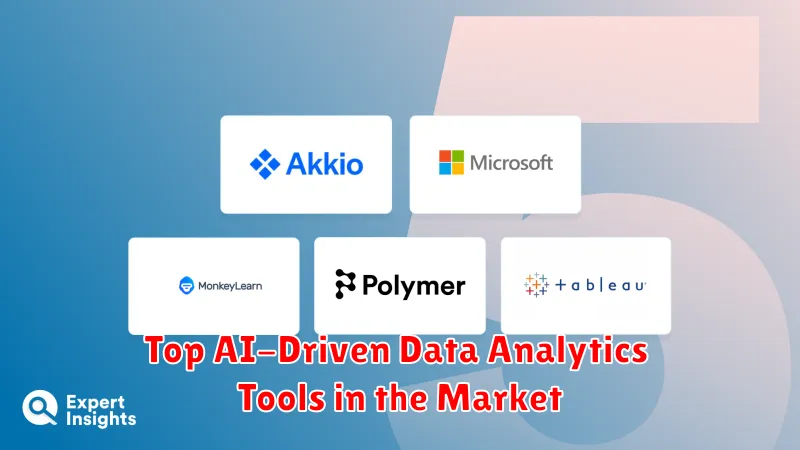
In today’s data-driven world, businesses are constantly seeking ways to extract meaningful insights from their data. This is where AI-driven data analytics tools come in, revolutionizing the way organizations analyze and interpret data. These tools leverage the power of artificial intelligence to automate tasks, uncover hidden patterns, and deliver actionable insights at an unprecedented scale. With a plethora of options available, choosing the right AI-driven data analytics tool can be daunting. This article delves into some of the top tools in the market, highlighting their key features and capabilities.
1. Google Cloud AI Platform: This comprehensive platform offers a suite of AI and machine learning services, including data preparation, model building, and deployment. Google Cloud AI Platform excels in scalability, making it suitable for large-scale data analysis projects. Its user-friendly interface and extensive documentation make it accessible to both seasoned data scientists and beginners.
2. Amazon SageMaker: As part of Amazon Web Services (AWS), SageMaker provides a fully managed platform for building, training, and deploying machine learning models. It offers a variety of pre-built algorithms and frameworks, making it ideal for quick prototyping and development. SageMaker’s integration with other AWS services streamlines data management and deployment processes.
3. Microsoft Azure Machine Learning: This platform offers a comprehensive set of tools for developing, deploying, and managing machine learning models. Azure Machine Learning integrates seamlessly with other Microsoft Azure services, providing a comprehensive data science ecosystem. It also includes features for automated machine learning, enabling users to build models with minimal coding.
4. DataRobot: A leading automated machine learning platform, DataRobot empowers businesses to build and deploy predictive models with ease. Its user-friendly interface and automated model selection processes make it accessible to users with varying technical skills. DataRobot’s focus on interpretability ensures that users understand the rationale behind the models’ predictions.
5. Alteryx: This data analytics platform combines data preparation, blending, and machine learning capabilities. Alteryx offers a drag-and-drop interface, simplifying the process of creating complex data workflows. Its robust analytics features allow users to uncover insights and make informed decisions.
These are just a few examples of the many AI-driven data analytics tools available in the market. The best tool for your organization will depend on your specific needs, data volume, and technical expertise. As AI technology continues to evolve, we can expect even more innovative and powerful tools to emerge in the future. By leveraging these tools, businesses can unlock the power of their data, gain a competitive edge, and drive better outcomes.
Use Cases Across Industries: From Finance to Healthcare
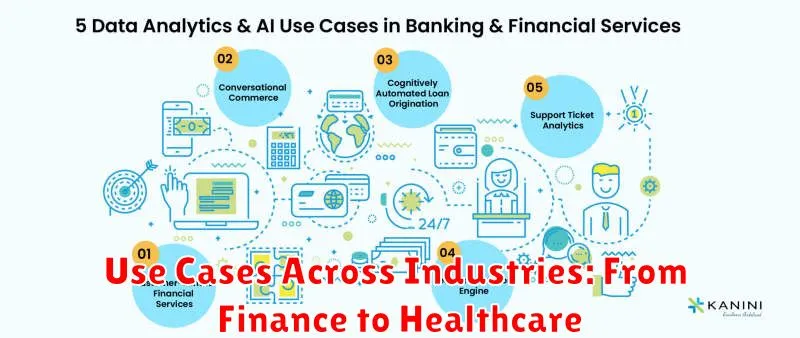
AI-driven analytics tools are transforming industries by unlocking the power of data. These tools offer advanced capabilities for analyzing vast datasets, identifying patterns, and generating actionable insights. Let’s explore how these tools are revolutionizing various sectors, from finance to healthcare.
Finance: AI-powered analytics are revolutionizing financial operations. From fraud detection and risk assessment to customer segmentation and personalized financial advice, these tools enhance efficiency and accuracy. For example, banks utilize AI to identify unusual spending patterns, flagging potential fraudulent transactions in real-time.
Healthcare: The healthcare industry is leveraging AI analytics to improve patient outcomes and optimize resource allocation. AI algorithms analyze patient data, predict disease risks, and assist in diagnosis. These tools also enable personalized treatment plans, streamline administrative tasks, and facilitate drug discovery.
Retail: AI-driven analytics are crucial for retail businesses to understand customer behavior, optimize inventory management, and personalize marketing campaigns. By analyzing data from online transactions, customer interactions, and social media, retailers gain valuable insights into customer preferences, allowing them to tailor product offerings and promotions effectively.
Manufacturing: AI is transforming manufacturing processes through predictive maintenance, quality control, and supply chain optimization. By analyzing sensor data from machines, AI tools can predict equipment failures, preventing downtime and improving operational efficiency. They also enable real-time quality control, ensuring product consistency and reducing defects.
Education: AI analytics are impacting education by personalizing learning experiences and providing insights into student performance. These tools can analyze student data, identify learning gaps, and recommend tailored learning resources. AI-powered chatbots can provide personalized support and answer student queries, enhancing their learning journey.
AI-driven analytics are becoming an indispensable tool across various industries, driving innovation, improving efficiency, and enhancing decision-making. As AI technology continues to evolve, we can expect even more transformative applications and impactful use cases in the years to come.
Choosing the Right AI Analytics Tool for Your Business
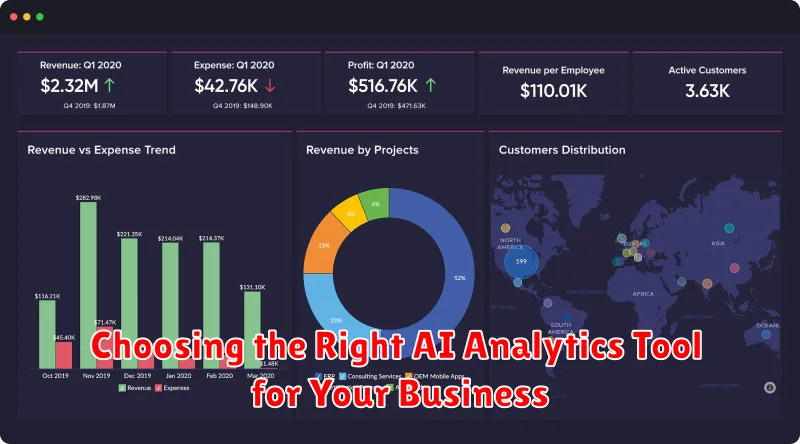
In today’s data-driven world, businesses are increasingly leveraging the power of artificial intelligence (AI) to gain insights from their data. AI analytics tools can help businesses automate tasks, identify trends, and make data-driven decisions, ultimately leading to improved efficiency and profitability.
However, with so many AI analytics tools available on the market, choosing the right one for your business can be a daunting task. Here are some key factors to consider when evaluating AI analytics tools:
1. Business Needs
The first step is to identify your specific business needs and goals. What kind of data do you need to analyze? What insights are you looking to gain? What are your budget constraints?
2. Data Integration & Compatibility
Ensure the tool can integrate seamlessly with your existing data sources and systems. Check for compatibility with your databases, applications, and cloud platforms.
3. AI Capabilities
Different AI tools offer varying levels of AI capabilities. Consider the types of algorithms, machine learning models, and predictive analytics features you require.
4. User Interface & Experience
The tool should be user-friendly and intuitive. Look for a platform that provides clear visualizations, dashboards, and reporting capabilities.
5. Scalability & Performance
Ensure the tool can handle your current and future data volumes. Consider the tool’s performance and response times to ensure efficient analysis.
6. Security & Compliance
Data security is crucial. Choose a tool that adheres to industry standards and provides robust security features to protect your sensitive information.
7. Support & Documentation
Evaluate the vendor’s customer support, training resources, and documentation. A comprehensive support system will ensure you can effectively utilize the tool.
By considering these factors, you can make an informed decision about the best AI analytics tool for your business. Investing in the right tool can unlock the power of your data and drive meaningful business outcomes.
Implementing AI-Driven Data Analytics: Best Practices

AI-driven data analytics is revolutionizing how businesses understand and utilize their data. But implementing these powerful tools effectively requires careful planning and execution. Here are some best practices to help you unlock the full potential of AI-driven analytics:
1. Define Clear Objectives: Before diving into AI, identify specific business problems you want to solve or questions you want to answer. This will guide your data selection, model choice, and ultimately, your success.
2. Ensure Data Quality: AI models are only as good as the data they’re trained on. Spend time cleaning, organizing, and validating your data to ensure accuracy and consistency. This includes addressing missing values, handling outliers, and standardizing formats.
3. Choose the Right Tools and Techniques: The AI landscape is vast, with various tools and techniques for different tasks. Consider your objectives, data characteristics, and team expertise when selecting the appropriate AI methods, like machine learning, deep learning, or natural language processing.
4. Start with Small, Focused Projects: Don’t try to boil the ocean. Begin with manageable AI projects that demonstrate value and build momentum. This allows for quicker iterations, learning, and refinement of your approach.
5. Foster Collaboration: AI projects often require input from multiple stakeholders. Ensure collaboration between data scientists, business analysts, and domain experts to ensure alignment and maximize the impact of your AI insights.
6. Monitor and Evaluate: Regularly assess the performance of your AI models and adjust as needed. Track key metrics, monitor for bias, and ensure your models remain relevant in a dynamic environment.
By following these best practices, you can effectively implement AI-driven data analytics to gain actionable insights, improve decision-making, and drive significant business value.
The Future of Data Analytics: Trends and Predictions
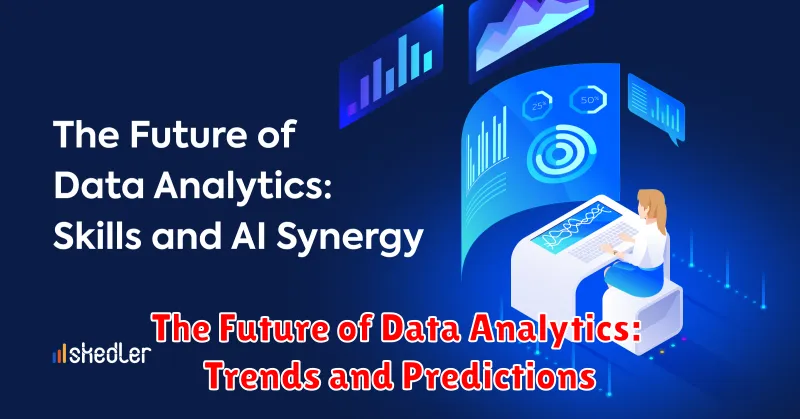
The field of data analytics is constantly evolving, with new technologies and trends emerging all the time. As we move into the future, we can expect to see even more significant advancements in this area, driven largely by the rise of artificial intelligence (AI).
One of the most significant trends in data analytics is the increasing use of AI-powered tools. These tools can automate many of the tasks involved in data analysis, such as data cleaning, feature engineering, and model building. This frees up data scientists to focus on more strategic tasks, such as understanding the results of their analysis and developing insights that can be used to improve business decisions.
Another trend is the growing importance of data democratization. This refers to the idea of making data more accessible to a wider range of users, including those who may not have traditional data science skills. This can be achieved through the use of user-friendly tools and interfaces, as well as through the development of new data visualization techniques.
In addition to these trends, there are a number of predictions about the future of data analytics. For example, experts believe that we will see a continued rise in the use of cloud-based data analytics platforms. These platforms offer a number of benefits, including scalability, flexibility, and affordability. We can also expect to see more widespread adoption of edge computing, which allows data to be analyzed at the point of collection, rather than being sent to a central data center.
The future of data analytics is exciting and full of potential. By embracing the latest trends and technologies, organizations can unlock the power of data to gain a competitive advantage and make better decisions.

